Tribal IAQ Equipment Loans
As part of the U.S. EPA's Region 10 Tribal IAQ Project, the WSU Energy Program loans monitoring equipment to tribal members.
The loan closet includes:
For information about borrowing the equipment, contact Todd Currier at 360-956-2038 or CurrierT@energy.wsu.edu. Equipment is often available with little or no waiting.
Carbon Dioxide Monitors
Adequate building ventilation dilutes and removes indoor air pollutants. Elevated carbon dioxide levels in buildings can lead to a variety of problems, including increased absenteeism, lower worker productivity, and increased incidence of indoor air complaints and episodes.
It is essential for building operations staff to monitor carbon dioxide as an indicator of outside air ventilation rates. Operations staff can often increase and decrease outside air ventilation rates to optimize comfort and energy efficiency, while maintaining sufficient air exchange to meet IAQ needs.
Routine calibration of carbon dioxide instruments ensures measurements are within a 10 percent accuracy range. The WSU Energy Program has calibration gases available for these adjustments.
Carbon dioxide monitor with data logger attached

Temperature and Relative Humidity Meters
Relative humidity is an important factor in occupant comfort and health, and mold prevention. Only about 80 percent of the occupants in a building are comfortable at any given temperature and relative humidity level. Using accurate and fast-acting instruments to check temperature and relative humidity helps operations staff provide a reasonable range of conditions so more people are comfortable more of the time.
Elevated relative humidity and cool or cold surfaces foster mold and bacteria growth. Managing temperature and relative humidity can help building operators protect building and finish materials from biological contamination, which can affect the health of occupants.
Fast-acting handheld instruments and data logging devices are available. The data logging devices provide trending information and graphics to help diagnose temperature and relative humidity problems.
Temperature and relative humidity meter with built-in dewpoint feature
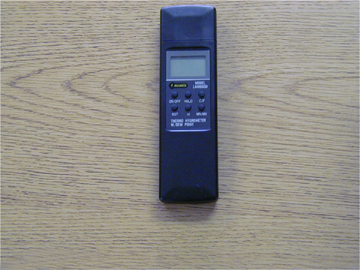
Data logger
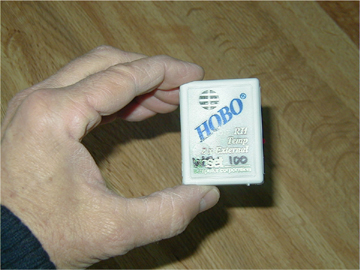
Carbon Monoxide Meters
A hand-held carbon monoxide meter detects the presence of this colorless, odorless gas and helps pinpoint its source. Carbon monoxide, a product of incomplete combustion, poses a serious health threat. Exposure to high concentrations can cause illness and death. Chronic exposure to relatively low concentrations also can be dangerous, especially to infants, the elderly, and those with certain health conditions. All buildings with combustion equipment should have a carbon monoxide alarm, but this is not always the case. Carbon monoxide alarms may fail due to sensor faults, power outages ,and dead batteries.
Carbon monoxide meter
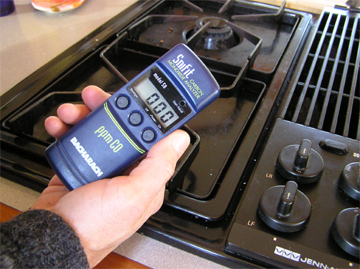
Radon Measurement Canisters
Radon is a naturally occurring radioactive gas found in soil across the Pacific Northwest. Inhaling radon can cause lung cancer, so it is important to prevent it from entering and accumulating in buildings. Some parts of the four-state U.S. EPA Region 10 have a higher probability of elevated indoor radon, which enters buildings from the soil or via water from wells. The only way to determine if radon is entering buildings is to use a test device. The WSU Energy Program provides these free to most tribes. Sample analysis is provided through an agreement with the U.S. EPA laboratory in Las Vegas.
Radon measurement canisters
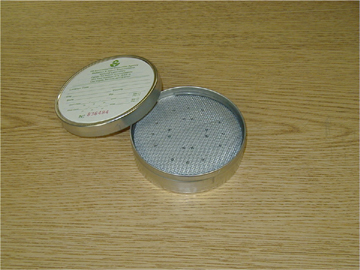
Particle Counters
Small airborne particles are a fact of life, outdoors and indoors. The smallest particles - 2.5 micrometers and smaller - are of most concern to human health. A particle-counting instrument is essential for monitoring concentrations and locating their source. Particle counters can also help facilities and maintenance personnel evaluate the effectiveness of custodial care, especially the cleanliness of carpets.
Particle counter

Measuring particles escaping from a vacuum cleaner
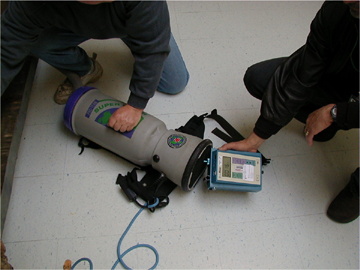
Flow Capture Hoods
A flow capture hood allows facilities and maintenance personnel to measure the volume of air coming out of supply-air diffusers and going into return- and outside-air intake grills. These are the same devices that air-balancing professionals use to adjust air-handling systems. These devices are useful for adjusting outside air delivery, and solving comfort and noise problems associated with air velocity.
Flow capture hood
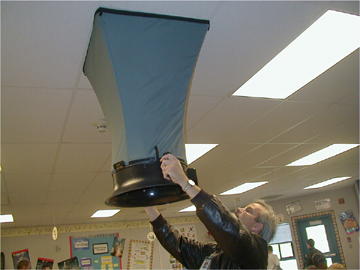
Tracer Smoke
Airflow direction in buildings is an important consideration and should be routinely checked. Very low airflows can easily be observed using a puff of chemical smoke or fine powder. While airflow direction is obvious when using this visual aid, the magnitude of the pressure cannot be determined.
Chemical tracer smoke bottle

Pressure Gauge
The accurate measurement of small pressure differences is often necessary to determine airflow directions and ensure air pollutants are contained to reduce human exposure. The digital micromanometer, capable of measuring in the 0.1 Pascal range, is an essential tool for use with blower doors and duct blaster equipment used to assess energy efficiency and IAQ.
Digital pressure gauge (manometer)
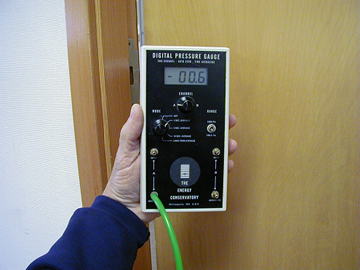
Moisture Meter: Pin-type and Contact-type
Moisture meters are used to locate damp or wet building and finish materials. Rapid detection of water leaks, spills, condensation, and other moisture sources reduces the potential for mold and bacteria growth, and prevents cosmetic and structural damage.
- Pin-type meters use two small pins to measure moisture content of materials; these leave small pin holes in the material tested.
- Contact-type meters are noninvasive and can detect damp or wet materials at depths not easily achieved with the pin-type meter.
Jim Woods, of the Makah tribe, measures moisture in a wall
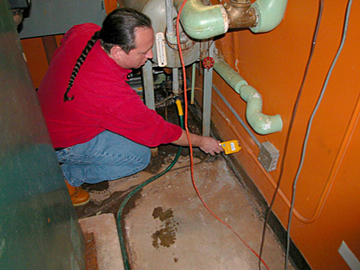
Pin-type moisture meter
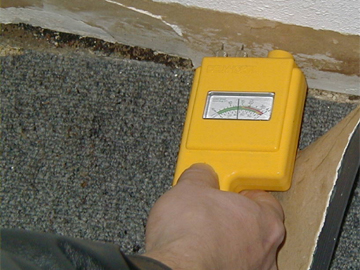
Contact-type moisture meter
